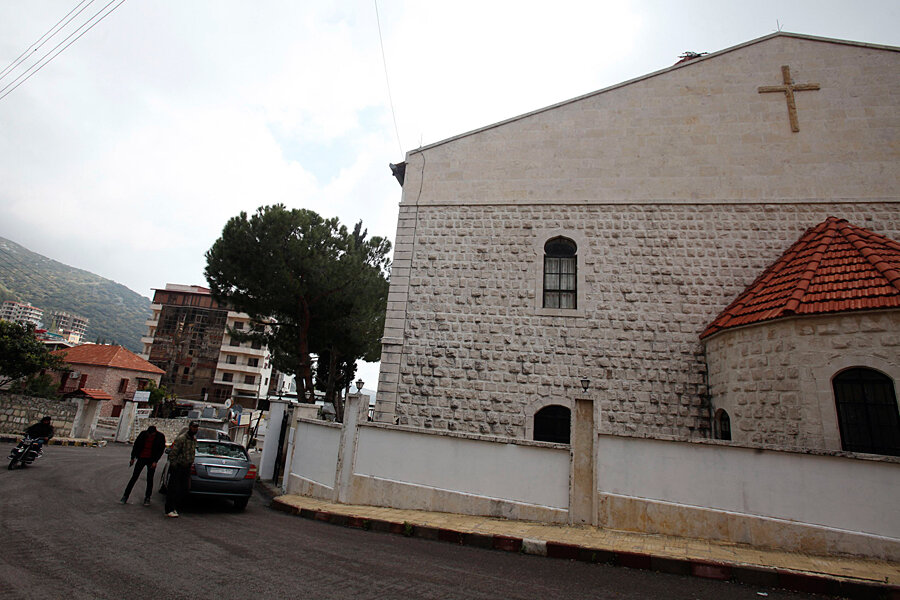Syria's latest battle: The PR fight over sanctuary for Christians
Loading...
| Beirut, Lebanon
When the Syrian opposition took over the Armenian-Christian town of Kessab in coastal Syria last month, its 2,000 residents fled. Given the presence of Al Qaeda-linked Jabhat al-Nusra and other Islamist groups, they feared the worst for their town.
So far, these fears have not been realized. Instead, rebels appear to be using Kessab as an opportunity to try to undo their reputation for extreme brutality towards Syria's Christians and Shiites. But the Assad regime, which considers itself the protector of minorities, has launched a media campaign to demonstrate how Islamists are terrorizing Christians in Kessab, turning the town into a public relations battlefield in Syria's civil war.
Christians' fears of the armed opposition have been stoked by events such as the Hatla massacre, in which at least 30 Shiite villagers were killed, and by snapshots of life under the control of extremist groups: strict Islamist doctrine, public beheadings of "infidels," and the alleged levying of a jizya, or protection tax, on some Christian communities by the Islamic State of Iraq and the Levant, an Al Qaeda-linked militant group.
Seizing on this reputation, the regime has flooded social media with shocking images of death and desecration of Shiite and Christian religious sites lifted from other events during the three-year-long war. Regime loyalists have even distributed a 2005 horror film called “Internal Damnation” to give the impression that a sectarian massacre took place.
The Syrian opposition has been quick to present its own narrative. Pro-opposition media have released videos of rebels helping elderly Kessab residents unable to flee regime airstrikes, and protecting local churches. Ahmed Jarba, the leader of the Syrian National Coalition, visited the town recently to demonstrate the opposition's willingness to protect the population.
The opposition-aligned Syrian Christians for Democracy called on US lawmakers to launch an inquiry into the regime’s “systematic abuse of the Christian community,” claiming that Syrian Armenians have been forcibly conscripted to fight with the regime.
Kessab remains in the hands of the opposition, which has pushed on to other parts of coastal Syria.
“As Armenians, we are not interested in the war of information that is taking place. Different parties have used the situation in Kessab to promote their own agendas,” says Father Paul Haidostian, head of the Haigazian University in Beirut.
The Turkey factor
History weighs heavily on Kessab's Armenians, whose presence in the town and the surrounding valley dates back to the 12th century. During the 1915 massacre, in which 1.5 million Armenians were killed, residents of the town, then under Ottoman jurisdiction, were deported to the deserts of Deir al-Zour, near the Iraqi border, and Jordan. Close to 5,000 people reportedly died. The survivors returned to Kessab by the 1920s.
The recent displacement is upsetting partially because of its familiarity, even if there is no evidence of violence, says Hagop Khatcherian, secretary general of the Lebanese-Armenian Tashnag Party, who recently traveled to Syria to assess the needs of the displaced.
The majority of the town's population has found safe haven in the coastal regime-controlled city of Latakia, despite Turkey's proximity. Around 80 families made their way to Lebanon, finding refuge with relatives in Beirut and the Armenian town of Anjar in the Bekaa Valley.
Some Kessab residents now in Beirut say the opposition's ground assault was preceded by an artillery bombardment launched from inside Turkey. Armenian media outlets have reported that the fighters passed through Turkish military barracks en route to Kessab, which is less than one mile from the border.
Both claims suggest a degree of Turkish complicity that has aggravated old wounds among Armenians and bred distrust of the opposition, given the bad blood between Armenians and Turkey, the modern state that emerged from the Ottoman Empire.
Last week Turkish Foreign Minister Ahmet Davutoğlu released a statement saying those displaced from Kessab were welcome in Turkey, which has already welcomed hundreds of thousands of Syrian Sunnis.
But Harout Yerganian, former head of the Lebanese Armenian Ramgavar Party, found the message insulting. "When my grandmother was deported during the genocide, a Turkish officer ripped out her left earring and stole it," he says. "I remember the scar when I was growing up.”
A childhood swim
Mego Apanian, an Armenian who grew up in Kessab, is sheltering his aunt and uncle in Beirut. “They are in shock,” he says. “They don't know if they will have homes to go back to.”
In a café in the Beirut's Armenian neighborhood of Bourj Hammoud, Apanian recalls his childhood in Kessab.
“When we were young, we used to go down to the beach in al-Samra, below Kessab, to swim. The Syrian side was very rocky but the Turkish side was sandy and more desirable," he says. Syrian border guards would allow the swimmers to cross into Turkey, while watching them with binoculars.
"If the Turkish border patrol came, they would shout and we would run back to the Syrian side. We grew up with this fear and distrust of Turkey.”
Despite its public relations campaign, the opposition is weighed down not only by its own record of targeting minorities but also its assistance from Turkey.
“Everyone knew the Assad regime was totalitarian, but the Armenian community was treated okay. The extremist groups in the opposition have made too many mistakes. There was no massacre, but the people of Kessab have had their peaceful, traditional way of life ripped away from them," Yergenian says.







